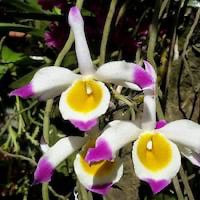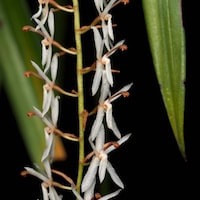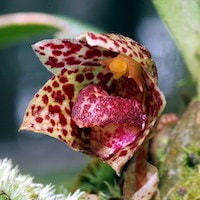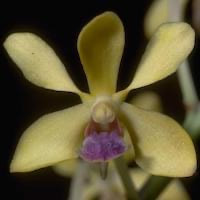MFR5 - Men's Fresh 5 - Neroli Bliss
|
Native Singaporean Orchid notes: Aerangis Modesta
This small orchid species grows as an epiphyte at altitudes between 100 and 1500 meters. It has short stems up to 15 cm long and obovate, fleshy leaves. From spring to early summer, it produces long, pendant flower spikes up to 50 cm long with 6 to 15 waxy, fragrant flowers. The flowers open one by one, with the first being the largest. They have a delightful, minty-spicy fragrance, especially strong at night.
|
Therapeutic Orchid notes:
|
Dendrobium crystallinum Rchb. f.
Dendrobium crystallinum, known as Hainanjinmao Shihu in Chinese, Ueang sai sam si and Ueang nang fawn in Thai, and Setkhu pan in Myanmar, is a medicinal orchid species. It has a long history of use, with the entire plant being utilized for various health benefits. Commonly called shihu, it is also known as zhong huan cha in some areas. This orchid's medicinal properties have been valued across different regions for a long time. |
|
Otochilus fuscus Lindl.
Xiaye Erchun Lan is a terrestrial orchid that blooms from December to January in Nepal and from November to January in Bhutan. It grows in Bhutan, Nepal, northeastern India, Yunnan, Myanmar, Thailand, and Indochina. In traditional medicine, the pseudobulbs of this herb are commonly used to treat fractures, highlighting its importance in healing practices across these regions. |
|
Bulbophyllum griffithi Syn. Bulbophyllum calodictyon Schltr., B. chitoense S.S. Ying, Sarcopodium griffithi Lindl
Duanchishiduo Lan, also known as the stone bean orchid and Xiaolushidaolan, grows in central Taiwan, southeastern Yunnan, Vietnam, northeast India, Bhutan, and Nepal. It blooms in February, August, and October to November in China, and in August in the Khasia Hills and Sikkim. In traditional medicine, its fresh and dry pseudobulbs are used to treat chronic coughs, bronchitis, sore throats, and to heal fractures and sores. |
|
Vanda testacea (Lindl.) Rchb.f. Syn. Vanda parviflora Lindl.
In Orissa, India, this orchid is called Malanga, and in traditional medicine, it is known as Rasna and Banda. In Thailand, it's named Khem lueang. Found in the Himalayas, Myanmar, Thailand, and Sri Lanka, it grows on trees at 800 to 2000 meters. Malanga contains compounds parviflorin and tessalatin and is used to treat rheumatism, earaches, asthma, and digestive issues. |
Other scent note
Soft-citrus combination with delicate-aqua notes
Scentopia Library Reference ingredient
Grape leaves - Check details at Scentopia's scent library
Download the guided mediation that works best with this Orchid fragrance oil
| men_fresh_essential_oil_orchi_00005.mp3 | |
| File Size: | 114507 kb |
| File Type: | mp3 |




